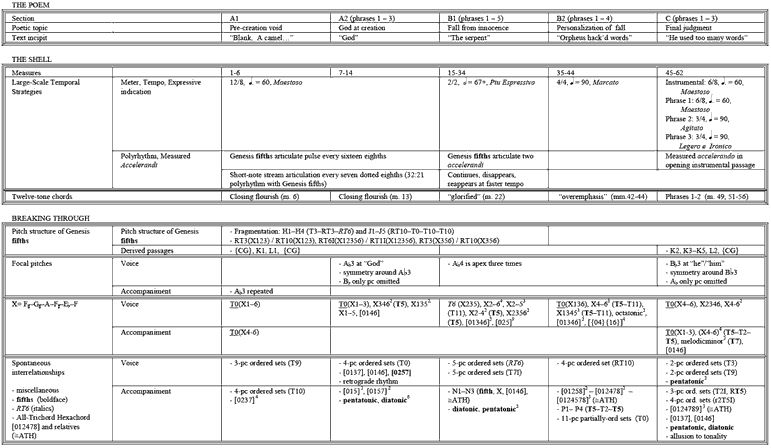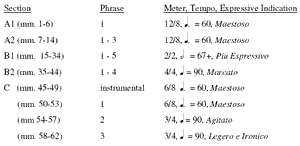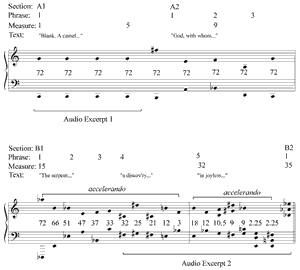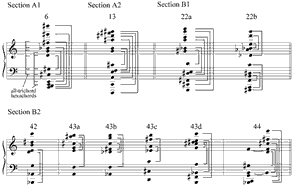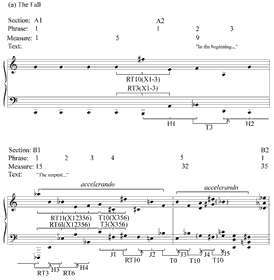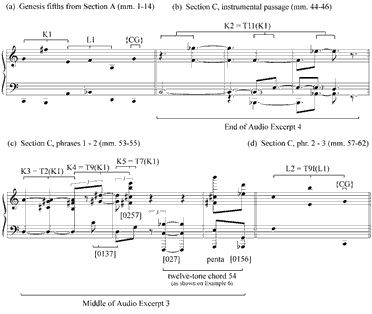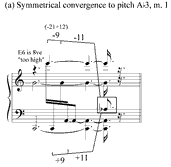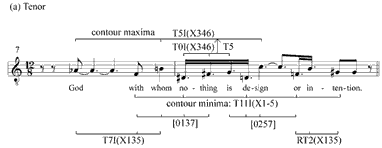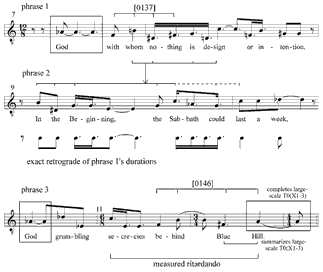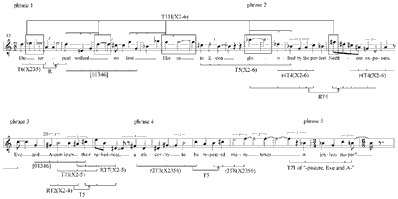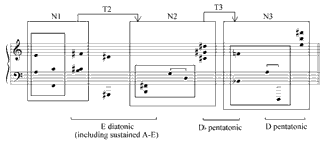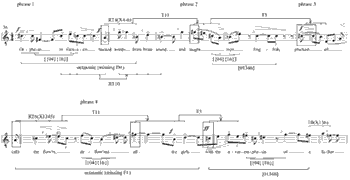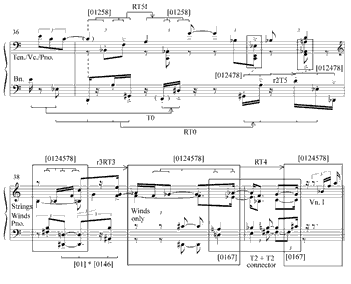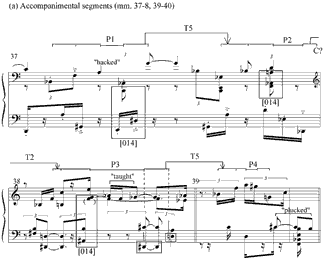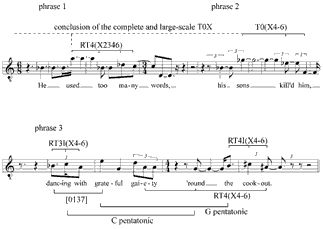Volume 13, Number 3, September 2007
Copyright � 2007 Society for Music Theory
Mark Sallmen*Listening to the Music Itself:
Breaking Through the Shell of Elliott Carter’s
|
|
KEYWORDS: vocal music, text-music relations, rhythm, atonal, set theory, Carter, Lowell, In Sleep, In Thunder
ABSTRACT: In “Music and the Time Screen” (1976), Elliott Carter outlines rhythmic procedures in several of his pieces, and then indicates that he has discussed only “the outer shell” and remained silent on “the issues and visions most important and significant during the act of composing.” Following up on these comments, I present a two-part analysis of his “In Genesis” from In Sleep, In Thunder (1981). Part I (“The Shell”) focuses on techniques emphasized in Carter�s writings—large-scale polyrhythms, metric modulations, notated accelerandi and all-interval twelve-tone chords. Part II (“Breaking Through”) deals with other topics: pitch relationships involving the perfect fifths that articulate the large-scale polyrhythms and notated accelerandi, focal pitches that encapsulate the divinity/humanity dichotomy in the poem, motivic unity in the vocal line, and other spontaneous interrelationships that contribute local and long-range coherence.
Received May 2007
[1] In “Music and the Time Screen” (1976), a paper in which Carter outlines rhythmic procedures in several of his pieces, he writes:
To have indulged in the foregoing explanations and to be faced with the prospect of their being used as a substitute for listening to the music itself and fed into the hopper of the American educational system—later to be ground up and to come out as undifferentiated fodder to be forcibly fed to the young and permanently regurgitated at exams—is apparently the terrible fate of such efforts as these and the disheartening result of America’s ambivalence toward the arts. Yet a composer cannot but be grateful for an opportunity to express verbally ideas important to him (for otherwise who would?) in the hope that they may be really helpful to a few others.
Perhaps the only consolation is that any such descriptive discussion as this has really consistently, although not intentionally, evaded the issues and visions most important and significant during the act of composing. For what is discussed here (as should be obvious, but never seems to be) is the outer shell, the wrapping of the music. The reason for writing it—for developing it in the way described, for weighing every note, chord, rhythm in the light of their expressive intention and their living, spontaneous interrelationships, and the judging of it all, almost unconsciously, against a private standard of what gives me genuine, sensuous pleasure, of what seems fascinating, interesting, imaginative, moving, and of urgent importance—cannot be put into words.(1)
[2] Carter says that he has addressed “the outer shell, the wrapping of the music” and remained silent on the “issues and visions most important and significant during the act of composing,” saying that these issues “cannot be put into words.” In a sense, we can take this at face value, words can not recreate the joys of the compositional process, but words can address the relationships that helped to generate the experience. But it is also clear that Carter is reluctant to put these issues into words because doing so might negatively impact public perception of him and his music: “In any discussion of specifically contemporary procedures, there are a few serious risks involved that must be constantly borne in mind. The first is the danger of rapid and wide dissemination of oversimplified formulas that shortens their life.”(2) Carter suggests that subsequent overuse by other composers would diminish the impact that these techniques have in his works. And in response to a question concerning program notes, Carter states “technical discussions baffle the greater part of the audience and the few who do understand are apt to feel that the composer is a calculating monster.”(3)
[3] Carter’s reticence notwithstanding, as serious students of his music we want to explore the “fascinating” details inside the “shell.” Indeed Carter’s contempt for intellectual passivity—revealed in the diatribe against the educational system and public attitude towards the arts—demands that we vigorously explore his music. But how do we approach the task? If Carter’s technical explanations are indeed analogous to a physical shell, then they foreshadow or hint at some aspects of their contents even as they protect and conceal other aspects. And so we are led to ask, to what extent and in what ways do Carter’s technical discussions elucidate structure in the music? How do the resulting interpretations provide starting points for further study? At what point do we shift attention away from the techniques that Carter mentions specifically and seek out others? What are these other methods of organization? And how do all of the various analytic results combine to give a sense of the depth and breadth of Carter’s compositional approach?
[4] The incredible variety within Carter’s writings and compositions suggests innumerable potential responses to these questions, but this paper explores only those that arise during the analysis of a single piece, “In Genesis,” the final song from the song cycle In Sleep, In Thunder (1981).(4) The analysis interacts with the writings of Carter and others in five principal ways, the first addressed in Part I of the article (“The Shell”) and the other four in Part II “Breaking Through.” “The Shell” addresses concepts that are emphasized in Carter’s writings, widely used in Carter’s music, and of central and large-scale importance to the song (large-scale rhythmic structures and twelve-tone chords).(5) “Breaking Through” explores pitch-class relationships among the pitches that articulate these large-scale rhythmic strategies. It also deals with well-documented features of Carter’s style whose role in other works is extensive and systematic but whose role in this song is merely secondary (all-interval tetrachords, the all-trichord hexachord and the calculated treatment of individual intervals).(6) Further, the paper draws on aspects of David Schiff’s work on Carter’s vocal music: its vigorous pursuit of text-music relations—Schiff and Carter both studied English literature before pursuing advanced musical training—and two specific analyses, one in which two focal pitches represent opposing poetic themes and another in which a member of the musical ensemble personifies a poetic character. (Schiff merits special mention in this context because of his close association with the composer; he is a former composition student and longtime friend of Carter’s and was chosen by the composer to author The Music of Elliott Carter). Finally, the analysis addresses concepts not uniquely associated with Carter’s music, but which are still vital to the song’s organization, such as the old-fashioned notions of thematic development and fragmentation of the opening theme and other concepts defined in the contemporary music-theoretic literature (cited below).
[5] “In Genesis” is scored for tenor and fourteen instruments (5 strings, 4 winds, 3 brass, piano and percussion) and sets Robert Lowell’s tragicomic commentary on humankind’s fall from innocence. The sonnet—which juxtaposes references to the garden of Eden, Lowell’s own life experiences, and other disparate images—divides into five sections (Example 1). Section A1 provides a one-word depiction of the pre-creation void (“Blank”) and a mocking portrayal of early creation. Section A2 describes God at creation: “God, with whom nothing is design or intention” implies that God has not predetermined humankind’s future, but “God grumbling secrecies” suggests that God senses impending doom. “Blue Hill” refers to the location of Harvard’s meteorological observatory, from which the heavens are viewed. The mixing of references to the beginning of time and to Boston, Lowell’s hometown, hints at the Adam/Lowell analogy that structures the remainder of the poem.(7) Section B1 comments on the fall from innocence in Eden and its subsequent “joyless” repetition by the rest of humanity. Section B2 personalizes the downfall by bringing in details from Lowell’s life: “Hacked words” and “taught men English” refer to his professional activities and “deflowered all the girls...” may refer to a personal life that included three marriages. “Plucked all the flowers” strengthens the association of Lowell to Adam, whose divine aspirations led him to pluck fruit from the Tree of Knowledge. Section C is final judgment: “He used too many words” denigrates Lowell’s life as a poet, and “His sons killed him, dancing with grateful gaiety round the cookout” indicates the tragic and ironic consequences of a flawed life. Overall, Section A (A1–A2) portrays God at creation, Section B (B1–B2) humanity’s fall from innocence and Section C God’s judgment of humanity.
Example 1. Robert Lowell, “In Genesis” from History (1973) in Collected Poems /Robert Lowell,
ed. Frank Bidart & David Gewanter (New York: Farrar, Strauss and Giroux, 2003),
423
A1 |
Blank. A camel blotting up the water. |
| A2 | God with whom nothing is design or intention. In the beginning the Sabbath could last a week, God grumbling secrecies behind Blue Hill . . . |
| B1 | The serpent walked on foot like us in Eden; glorified by the perfect Northern exposure, Eve and Adam knew their nakedness, a discovery to be repeated many times . . . |
| B2 | in joyless stupor?. . . Orpheus in Genesis hacked words from brute sound, and taught men English, plucked all the flowers, deflowered all the girls with the overemphasis of a father. |
| C | He used too many words, his sons killed him, dancing with grateful gaiety round the cookout. |
|
“In Genesis” from COLLECTED POEMS by Robert Lowell. Copyright © 2003 by Harriet and Sheridan Lowell. Reprinted by permission of Farrar, Straus and Giroux, LLC. |
|
[6] Part I of the analysis (“The Shell”) shows that large-scale rhythmic strategies outlined in “Music and the Time Screen” play important structural roles in articulating the poem’s form and content. First, various tempi, the metric modulations that connect them, and other surface features clearly reinforce the structure of the poem. Most notably, Maestoso (dotted quarter = 60) is associated with God, both during Section A (A1–A2) and at final judgment in Section C. Second, large-scale polyrhythms and measured accelerandi organize the background of Sections A1, A2, and B1: a series of slow-moving sustained perfect fifths, the Genesis fifths, portrays the constancy of God with a consistent rate in Section A and the fall from innocence with measured accelerandi in Section B1. The overlaying of a series of accented, short notes, hereafter “the short-note stream,” creates one of Carter’s trademark large-scale polyrhythms. Part I also points out that Carter’s famed RT6-invariant, all-interval, twelve-tone chords mark dramatic highpoints in each section of the song—the closing flourishes of Sections A1 and A2 and the settings of “glorified,” “overemphasis,” and “kill’d him” in Sections B1, B2 and C, respectively.
[7] These rhythmic features and twelve-tone chords contribute overall coherence and account for a few salient features, but they leave the majority of the song unexplained and do not address the vocal line at all. Part II of the analysis, “Breaking Through,” delves deeper in four ways. First, it studies pitch relations among the perfect fifths that articulate the large-scale rhythmic strategies. Most notably, two trios of fifths, defined below as H1 and J1, are each subjected to standard developmental techniques (sequence and fragmentation), creating moment-to-moment coherence throughout the passage—and a depiction of the breaking apart that results from a body/spirit plummeting out of control. In addition, specific fifths articulate tonal anchor points and fragments of the Genesis fifths engender similar passages in Section C. Concerning text-music relations, the intervals of the perfect fifth and tritone seem to represent God and humanity/evil, respectively. The perfect Genesis fifths ring loudest and clearest during Section A (God), become quieter and less prominent during Section B1 (humankind’s fall from God’s grace), disappear during Section B2 (enumeration of the poet’s sins), and resurface at the beginning of Section C (God’s judgment of humanity). Salient tritones appear at humankind’s entrance into God’s perfect creation, at “the serpent” in Eden, and at God’s angry judgment of humanity.
[8] Taking cues from text-music relations in Schiff’s book on Carter, the analysis points out that the poem’s divinity/humanity dichotomy is also depicted by two focal pitches, A![]() 3 (God) and B
3 (God) and B![]() 3 (humanity), and by the interaction between the tenor voice (Adam/Lowell/humanity) and the instrumental ensemble (God).(8)
3 (humanity), and by the interaction between the tenor voice (Adam/Lowell/humanity) and the instrumental ensemble (God).(8)
|
[9] Third, as might be expected from the setting of a poem that draws analogies between Eden and subsequent human existence, the song draws melodic material from its genesis, the vocal line of Section A1, hereafter called X. Since such references arise within discussions that also address other matters, it is helpful to establish an efficient way to refer to fragments of X. Example 2 displays X’s pitches without rhythm, F |
Example 2. X, pitches of Section A1 vocal line (click to enlarge) |
[10] X has several structural roles in the song. First, the appearance of various X fragments throughout the vocal line unifies the entire song. Further, specific X fragments tend to be prevalent in one section but scarce in others, which creates greater coherence within sections and greater differentiation between sections. For example, there are four references to X2–6 in Section B1 and zero in other sections, which unifies Section B1 and distinguishes it from the remainder of the song. Finally, fragments of T0X anchor important moments and a complete, large-scale statement of T0X organizes the vocal line as a whole.
[11] Fourth and finally, in addition to focal pitches and fifth- and X-related structures, Part II of the analysis identifies “spontaneous interrelationships.” Some of these interpret the vocal line alone and others address the combination of the vocal line with the compositional layers outlined above (Genesis fifths, short-note stream, twelve-tone chords) or with other instrumental passages yet to be mentioned. Most of these relationships involve (R)/Tn/I-related ordered, unordered or partially-ordered pitch-class sets that contribute to local continuity: for example, RT6-related five-note ordered sets (that are not subsets of X) constitute phrase 2 of Section B1, unordered set type [0237] structures the Section A1 flourish, and a series of partially-ordered sets, P1–P4, articulates T5–T2–T5, thereby organizing the complex polyphonic texture in the first half of Section B2.(10) These relations are quite straightforward to pull from the texture because most involve pitches that are adjacent, either within a single instrumental line or within the texture as a whole. Relationships that do not involve adjacent pitches are nonetheless prominent because they are articulated by contour maxima and minima (melodic highpoints and nadirs respectively)(11) or reinforced by attack-point rhythm (the ordered series of durations measured from the attack of one note to the attack of the next).
[12] The primary purpose of the spontaneous interrelationships seems to be to furnish local continuity, but the ones that engage the movement’s principal pitch-class features—twelve-tone chords, perfect fifths and X—also contribute to the song’s overall coherence. The signature interval of the Genesis fifths is re-emphasized by T5, T7 and fifth-saturated collections ([027], [0257], pentatonic, diatonic, etc.). Features of the twelve-tone chords also echo throughout the analysis. RT6 organizes not only the twelve-tone chords, but also several chords with fewer than twelve pitch classes, a passage from the Genesis fifths, and several fragments of the vocal line. In a more subtle way, set types that maximize diversity resonate with the all-interval nature of the twelve-tone chords. All-interval tetrachords [0146] and [0137], the first of which is also a subset of X, appear in each section of the song and the all-trichord hexachord [012478] and related sets organize passages within Sections B1, B2 and C. Finally, it bears emphasizing that a single relationship often engages several of song’s principal harmonic features, a prime example being N1–N3 in Section B1, which projects on three structural levels the perfect fifth, X subset [025], and all-interval tetrachord and X subset [0146].
[13] The chart in Example 3 gives a detailed overview of the paper’s analytic components, organized into columns by section (and poetic topic) and into rows by analytic topic: temporal strategies and twelve-tone chords in “The Shell” and perfect fifths, focal pitches, X and spontaneous interrelationships in “Breaking Through.”
I. The Shell
Large-Scale Temporal Strategies
|
[14] As shown in Example 4, changes in expressive indication, tempo, and meter articulate the large-scale poetic structure.(12) Expressive indication (Maestoso), meter (12/8), and tempo (dotted quarter = 60) unify Section A, which focuses on God.(13) The most complicated metric modulation of “In Genesis,” which involves three steps, articulates the poetic division between Sections A and B. Section B1’s slightly faster tempo (67+) and Piu Espressivo provide the agitation appropriate for the beginning of the fall from innocence and Section B2’s Marcato indication signals Lowell’s personalization of the downfall. The return of Maestoso and dotted quarter = 60 at the beginning of Section C coincides with God’s return to judge humanity. The dramatic vocal phrases of Section C are distinguished from one another by changes in meter, tempo and/or expressive indication.(14) |
Example 4. Overall Form of Elliott Carter’s “In Genesis” (click to enlarge) |
[15] Sections A and B1 feature the Genesis fifths, a succession of sustained perfect fifths (or octave compounds thereof) stated most often by the brass and woodwinds but occasionally by the strings. The consistent tempo of Section A’s Genesis fifths symbolizes the constancy of God; in the prevailing 12/8 meter a Genesis fifth is articulated every sixteen eighths so that every third Genesis fifth coincides with every fourth notated downbeat (mm. 1, 5 and 9).(15) The acceleration of the Genesis fifths during Section B1 vividly portrays the fall from innocence. This musical depiction of the spiritual fall is analogous to the acceleration (due to gravity) inherent in a physical fall. There are two accelerandi. The first begins with the duration of Section A’s Genesis fifths, now notated as three complete measures in 2/2 where the half note = 67.5, and gradually shortens its durations until the last is one eighth-note in length. This accelerando spans seventeen measures and sets four poetic phrases, in contrast to the second one, which lasts a few measures and sets the brief fragment “in joyless stupor?” with durations that decrease gradually from a dotted half to a dotted sixteenth. This rhythmic intensification is accompanied by textural thickening, during which fifth dyads lead to larger chords, either stacked fifths or the fifth-containing trichord [025]. The Genesis fifths and their rhythmic relationships are displayed in Example 5, where numerals between the staves indicate durations measured from the attack of one Genesis fifth to the attack of the next. The (arbitrary) labeling of the starting duration as 72 gives integral values for most durations in the sequence.(16) |
Example 5. Rhythmic features of the Genesis fifths (click to enlarge and see the rest) |
[16] In addition to the Genesis fifths, Sections A and B1 include a series of accented, short notes—hereafter called the short-note stream—creating one of Carter’s trademark polyrhythms. During Section A, the string instruments articulate a pulse every seven dotted eighths, 32/21 faster than the Genesis fifths. The harassment of God’s “perfect” Genesis fifths by these incessant short notes portrays conflict in Creation and/or the awkward gait of the camel. In Schwartz’s words, “Carter’s picture of the void out of which creation emerges is wickedly satirical.”(17) The short-note stream’s
accelerando during the metric modulation between Sections A2 and B1 foreshadows—or perhaps instigates—the Genesis fifths’
accelerandi during B1. The short-note stream articulates a faster constant tempo during phrase 1 of Section B1, disappears during phrase 2, and resurfaces in phrases 3–5 with the strings’ persistent repetition of pitch C![]() 4, word painting for “to be repeated many times” (Audio Excerpts 1 and 2).(18)
4, word painting for “to be repeated many times” (Audio Excerpts 1 and 2).(18)
| Audio Excerpt 1: | Audio Excerpt 2: |
Twelve-Tone Chords
[17] RT6-invariant, all-interval, twelve-tone chords also play a prominent role in this song. These chords and some fewer-pc relatives are listed in Example 6. (Chords are labeled by the measure in which they occur and, where two or more chords occur in the same measure, also by letters as with chords 22a and 22b. In some cases all twelve notes in a chord sound simultaneously in the music but in others the chord is a combination of several adjacent events.) Chord 13 is a stereotypical example: it includes each pitch-class interval exactly once (10–9–7–1–8–6–4–11–5–3–2 ordered from low to high), it features tritone nesting (RT6 invariance) shown by nested brackets on the example, and like most others in the song its top and bottom hexachords articulate [013458]. Other chords deviate somewhat from this model. In chords 22b and 52a the hexachords map onto themselves (not each other) under RT6. Chords 42-44 rely on RT6 but do not form complete twelve-tone chords. Chord 44 is two pcs short of the full twelve, chords 43a-d contain pitch classes that do not participate in the RT6 structure, and chord 42’s top hexachord realizes the popular [013458] but its RT6 pair is incomplete.(19) Chord 6’s segmental embedding of the all-trichord hexachord recalls a similar practice in Night Fantasies, the work composed immediately prior to In Sleep, In Thunder.(20) |
Example 6. RT6-invariant, all-interval twelve-tone chords (click to enlarge and see the rest) |
[18] These chords provide the tonal material for the flourishes at the end of Sections A1 and A2 (chords 6 and 13), for the high, sustained vocal A![]() 4s at “glorified” in B1 (chords 22a–b) and “all” in B2 (42–44) and for climactic final judgment in Section C (49–56). The musical realizations of the chords vary considerably. For instance, chords 6 and 13 are pianistic arpeggiations whose sustaining pitches are reinforced by other instruments; 22a and 22b are each sustained string chords; and 42-44 are “overemphatic” accented
tutti punches. Chords 51a-c occur multiple times in quick succession during the vocal climax at “used,”
4s at “glorified” in B1 (chords 22a–b) and “all” in B2 (42–44) and for climactic final judgment in Section C (49–56). The musical realizations of the chords vary considerably. For instance, chords 6 and 13 are pianistic arpeggiations whose sustaining pitches are reinforced by other instruments; 22a and 22b are each sustained string chords; and 42-44 are “overemphatic” accented
tutti punches. Chords 51a-c occur multiple times in quick succession during the vocal climax at “used,”
| Audio Excerpt 3: |
[19] The analytic techniques employed so far introduce the song: large-scale temporal strategies articulate primary poetic features and twelve-tone chords mark important structural pillars. Yet the analysis has barely mentioned the vocal part and there is much more to the accompaniment than a succession of parallel fifths and twelve-tone chords. In fact, seventy-five percent of the song’s pitch material remains neglected.
II. Breaking Through
Pitch Structure in the Genesis Fifths
[20] The articulation of the aforementioned rhythmic strategies by a single interval type, the perfect fifth, makes it straightforward to study pitch-class structures, which also engage the poetic structure. First, particular Genesis fifths highlight formal boundaries. {C2 G4} endures throughout Section A1 and returns at the end of Section A2, framing the entire A Section. {D![]() A
A![]() }–{E B} begins Section B1 and its retrograde, embedded within {E B F
}–{E B} begins Section B1 and its retrograde, embedded within {E B F![]() }–
}–![]() A
A![]() E
E![]() },
},![]() F} marks both the conclusion of the first
accelerando and the beginning of the second (Example 7).
F} marks both the conclusion of the first
accelerando and the beginning of the second (Example 7).
|
[21] Second, Genesis fifths embed parallel fifth-related references to X such as RT10(X1-3) and RT3(X1-3) in the lower and upper strata, respectively.(22) [22] Third, two groups of three Genesis fifths, H1 and J1, are each subjected to standard developmental techniques (sequence and fragmentation), creating moment-to-moment coherence throughout the passage—and a depiction of the breaking apart that results from a body/spirit plummeting out of control. Fifths within H1 articulate T10–T1, as do those within H2, the order-preserving T3 transposition of H1. The last fifth in each group arrives on the downbeat at the beginning of a new poetic sentence, {B |
Example 7. Pitch structure in the Genesis fifths |
[23] J1 undergoes a similar set of transformations—fragmentation and sequencing by (R)T10. The J sequence begins in a straightforward manner but becomes hidden towards its end because G–F![]() –B
–B![]() during J4–J5 do not fit into the scheme and because repeated fragmentation whittles the J motive down to a single fifth at J5—which is in fact realized as a fourth {G3 C4}. The J series both begins and ends with {C G}. Since J1 is precisely T3(X356) / T10(X356), the entire J series is X-derived.
during J4–J5 do not fit into the scheme and because repeated fragmentation whittles the J motive down to a single fifth at J5—which is in fact realized as a fourth {G3 C4}. The J series both begins and ends with {C G}. Since J1 is precisely T3(X356) / T10(X356), the entire J series is X-derived.
[24] The fall—so vividly dramatized by the accelerandi, motivic disintegration, and piling up of fifths—lands with a crash at the beginning of Section B2 (see Example 7b). At this point there are two strata of stacked fifths/fourths (treble-register triplet eighths and bass-range sixteenths) that together form an aggregate-completing set of [027]s. These fifth-saturated [027]s transform into half-step-saturated [012]s, a change highlighted by the shift from legato to accented staccato.(23) Subsequently, stacked fourths literally fracture into a linear string that is punctuated by additional half-step-saturated sets. The simultaneous perfect fifth dyads have been destroyed and are absent from the remainder of Section B2, an apt musical analogy for God’s absence from Lowell’s flawed life.
[25] Poetically, Section C marks the return of God to judge Lowell/humanity; musically, fragments of Section A’s Genesis fifths return, transformed, as shown by K1–K5 and L1–L2 on Example 8. Because they are related to one another by transposition, each K articulates the same series of operators, T11–T10. Complicating matters somewhat, K2, K4, and K5 are inexact copies of K1 because they add, omit, and/or reorder pitch classes. (Partially-ordered sets for model and actual versions are juxtaposed below the example.) K2 is a series of [016] whose rhythm and spatial layout highlight the unfolding of T11–T10. The attack-point rhythms of the second and third subsets are identical to one another and precisely half that of the first. The outer voices articulate the (divine) perfect fifths while the middle voice contributes an extra pitch class that creates (angry/evil) tritone and minor ninth dissonance. Accented short chords (not shown) add further dissonance and drama to the attack points of the sustained B and {F G |
Example 8. Fifth-based passages in Section C |
| Audio Excerpt 4: |
Focal pitches
[26] The special treatment of two pitches encapsulates the poem’s divinity/humanity dichotomy. A |
Example 9. Focal pitches and the divinity/humanity dichotomy |
[27] This avoidance of B![]() 3 is significant because B
3 is significant because B![]() 3 is precisely the focal pitch and inversional axis of the vocal line of Section C, whose poetic topic is the judgment of flawed humanity. B
3 is precisely the focal pitch and inversional axis of the vocal line of Section C, whose poetic topic is the judgment of flawed humanity. B![]() 3 appears five times, anchoring phrase beginnings and endings. Of special note are the lengthy B
3 appears five times, anchoring phrase beginnings and endings. Of special note are the lengthy B![]() 3s that set words that refer directly to Lowell (“he” and “his”), which creates a direct parallel to the pair of lengthy A
3s that set words that refer directly to Lowell (“he” and “his”), which creates a direct parallel to the pair of lengthy A![]() 3s that set “God” in Section A. Concerning symmetry, phrases 1 and 2 each begin with a lengthy B
3s that set “God” in Section A. Concerning symmetry, phrases 1 and 2 each begin with a lengthy B![]() 3, end with pitch interval –10, and include pitch interval 8 along the way. While the opening B
3, end with pitch interval –10, and include pitch interval 8 along the way. While the opening B![]() remains constant, other pitches are subjected to complementary transpositions, T+3 and T–3. The resulting narrower range of phrase 2, along with its shorter total duration and fewer syllables/notes, suggests hearing phrase 2 as a condensed version of phrase 1. In addition, phrases 2 and 3 articulate symmetrical convergence to B
remains constant, other pitches are subjected to complementary transpositions, T+3 and T–3. The resulting narrower range of phrase 2, along with its shorter total duration and fewer syllables/notes, suggests hearing phrase 2 as a condensed version of phrase 1. In addition, phrases 2 and 3 articulate symmetrical convergence to B![]() 3. Moreover, the vocal lines of Sections A and C
exclude each other’s focal pitch classes—that is, B
3. Moreover, the vocal lines of Sections A and C
exclude each other’s focal pitch classes—that is, B![]() is the only pitch class not sung during Section A and A
is the only pitch class not sung during Section A and A![]() is the only pitch class not sung during Section C (Example 9c).(26)
is the only pitch class not sung during Section C (Example 9c).(26)
[28] The divine A![]() also plays an important role during Section B, where A
also plays an important role during Section B, where A![]() 4 appears at three vocal apexes (Example 9d). These moments are particularly striking because A
4 appears at three vocal apexes (Example 9d). These moments are particularly striking because A![]() 4 is the highest note of the song so far. Recalling that Adam and Eve’s fall from grace resulted from their attempt to be like God by eating the forbidden fruit of the Tree of Knowledge, it is possible to read a text-music parallelism between Adam and Eve’s divine aspirations and the vocal line’s repeated reaching up to the divine pitch class, A
4 is the highest note of the song so far. Recalling that Adam and Eve’s fall from grace resulted from their attempt to be like God by eating the forbidden fruit of the Tree of Knowledge, it is possible to read a text-music parallelism between Adam and Eve’s divine aspirations and the vocal line’s repeated reaching up to the divine pitch class, A![]() .(27)
Divine aspiration becomes unforgivable sin when the voice ascends above A
.(27)
Divine aspiration becomes unforgivable sin when the voice ascends above A![]() 4, to A4 at “father.” This leads directly to God’s angry response, K2, the dramatic tritone-infused recollection of the opening trio of Genesis fifths cited above (Audio Excerpt 4).
4, to A4 at “father.” This leads directly to God’s angry response, K2, the dramatic tritone-infused recollection of the opening trio of Genesis fifths cited above (Audio Excerpt 4).
X and Spontaneous Interrelationships
[29] The remainder of the paper combines the presentation of X and spontaneous interrelationships, addressing each of the song’s five sections in turn. Each section treats the vocal line alone first and then studies the interaction of different instrumental strata in the texture as a whole.
Section A1
[31] The A1 flourish concludes and summarizes the section and beautifully demonstrates Carter’s ability to control the
interaction of multiple compositional layers. The flourish, which realizes twelve-tone chord 6 from Example 6 above, begins with an approximation of measure 1 (the initial notes of the Genesis fifth and short note streams embellished with a brief piano arpeggio) and ends with the pitch classes that conclude the vocal line, {E |
||||||||||||
Section A2
[33] Example 11b helps to point out a profusion of other local relationships that arise from the interaction of the vocal line, the Genesis fifths, and the short-note stream. First, the harmonization of “or intention” fuses two segments that occur separately during “God with whom.” The RT3 transformation of {B E
Section B1
| ||||||||||||
Section B2
[43] Third, it is also possible to hear continuity throughout these phrases by focusing on P1 = { {B |
||||||||||||
Section C
[46] The song’s postlude summarizes the entire song’s reliance on X through a thorough treatment of X4–6 and a final nod to X1–3, and recalls the initial vocal utterance of the song, F |
||||||||||||
[47] In this two-part analysis, “The Shell” has focused on large-scale temporal strategies and twelve-tone chords, and “Breaking Through” has addressed pitch organization in the Genesis fifths, a pair of focal pitches, X and other spontaneous interrelationships, all of which resonate deeply with the form and content of Lowell’s poem. These primary categories organize and unify the complex web of associations that arises from the paper’s numerous interpretation types. Diverse pitch-class interpretations track ordering totally, partially, and not at all, attend to individual instrumental layers and their interaction, and address both local and global associations—and other interpretations address rhythm, meter, tempo, and other features.
[48] In the passage from “Music and the Time Screen” quoted at the outset of this paper, Carter expresses dread that his comments about his music may be used in educational institutions “as a substitute for listening to the music itself.” I take this to have a two-fold meaning. Not only is there a concern that time spent in the classroom learning these “facts” will impinge upon time spent in the concert hall attending live musical performances, but also that over-reliance on Carter’s words—after all he is the composer—will discourage independent exploration of the music. While these fears may have, at times, been realized, Carter’s writings have also been “really helpful to [more than] a few others,” providing starting points for exploration of his vast and varied oeuvre. But Carter’s music also includes numerous other types of organizational structures that his writings do not explicitly identify. This should be expected from the works of a composer so well acquainted with a wide array of musical styles and who has had so many years to consider different compositional strategies. For even when he wrote this song twenty-five years ago, Carter had already been composing for more than a half century. At least in the case of “In Genesis,” it is by invoking a diverse set of analytic tools, only some of which are mentioned in Carter’s writings, that we begin to get a realistic sense of the depth and breadth of Carter’s approach. As Carter writes of the compositional process:
Compositions are the result of innumerable choices—many unconscious, many conscious, some quickly made, others after long deliberation, all mostly forgotten when they have served their purpose�What [the composer] is aiming at, after all, is a whole in which all the technical workings are interdependent and combine to produce the kind of artistic experience that gives a work its validity and in so doing makes all its procedures relevant.(38)
Mark Sallmen
University of Toronto
mark.sallmen@utoronto.ca
References
1. Elliott Carter, “Music and the Time Screen,” in
Elliott Carter: Collected Essays and Lectures, 1937–1995, ed. Jonathan W. Bernard (Rochester: University of Rochester Press, 1997), 280.
Return to text
2. Elliott Carter, “Shop Talk by an American Composer” in
Collected Essays, 215. Bernard mentions Carter�s reluctance to write about his own music (Collected Essays, viii), a topic taken up and embellished with personal anecdotes by Andrew Mead in his review of the collection in
Theory and Practice 27 (2002): 99–114 (esp. 107–08).
Return to text
3. Carter, “Shop Talk” in Collected Essays, 217–18.
Return to text
4. The song has not been discussed in Carter’s published writings and has received minimal treatment in scholarly work in general: Lloyd Schwartz (in “Elliott Carter and American Poetry,”
Sonus 19/1 (Fall 1998): 12–25) and David Schiff (in The Music of Elliott Carter, 199) each provide a one-page commentary on “In Genesis” within a survey of Carter’s solo vocal works. Brenda Ravenscroft compares the polyrhythmic structures of “In Genesis” and “Anaphora” in “Design and Intention: Elliott Carter�s Setting of ‘In Genesis’,” (Canadian University Music Society Annual Conference, Halifax 2003), a paper that draws on her dissertation, “Texture in Elliott Carter’s
A Mirror on Which to Dwell” (Ph.D. diss., University of British Columbia, 1992), and on mine, “A Flexible Approach to Ordering and Grouping in Atonal Music in General: Text-Music Relationships in Elliott Carter’s In Sleep, In Thunder In Particular” (Ph.D. diss., University of Rochester, 1998).
Return to text
5. Carter discusses all of these rhythmic ideas in “Time Screen” in Collected Essays, 262–80. Elsewhere in Collected Essays, Carter comments on polyrhythm in “The Orchestral Composer�s Point of View” (1970), 243–46, and on measured accelerandi and ritardandi in “The Time Dimension in Music” (1965), 227, and “On Saint-John Perse and the Concerto for Orchestra” (1974), 252. Carter, “Point of View,” 248, mentions the twelve-tone chords in the Piano Concerto (1965). For introductions to all of these topics and others, an overview of Carter’s work, and a comprehensive bibliography consult David Schiff, The Music of Elliott Carter, 2d ed., (Ithaca: Cornell University Press, 1998). The distinction between Carter’s writings and those of his student Schiff is somewhat vague, especially since Carter himself suggests that Schiff represents the composer’s views. See Elliott Carter, “To the Editor,” MLA Notes 41/1 (1984): 195; this is a response to Andrew W. Mead, review of The Music of Elliott Carter, by David Schiff, MLA Notes 40/3 (1984): 544�47.
Since the scholarly literature that elaborates on these compositional techniques in Carter’s work is considerable, I will mention only a few other sources. Jonathan Bernard provides an account of Carter’s rhythmic procedures in “The
Evolution of Elliott Carter’s Rhythmic Practice,” Perspectives of New Music 26/2
(1988): 164–203. For discussions of the all-interval, twelve-tone chords in
Night Fantasies consult the sketch-based study by John Link, “The Composition of
Elliott Carter’s Night Fantasies,” Sonus 14/2 (1994): 67–89; and Andrew Mead,
“Twelve-Tone Composition and the Music of Elliott Carter,” in Concert Music,
Rock, and Jazz since 1945: Essays and Analytic Studies, ed. Elizabeth West
Marvin and Richard Hermann (Rochester: University of Rochester Press, 1995),
67–102. Tiina Koivisto, “Syntactical Space and Registral Spacing in Elliott
Carter’s Remembrance,” Perspectives of New Music 42/2 (2004): 158–89, addresses
Remembrance (1988) and David Schiff points out twelve-tone chords in “Dolphin”
in “In Sleep, In Thunder: Elliott Carter’s Portrait of Robert Lowell,”
Tempo 142
(1982): 2–9. For a study of the general properties of all-interval twelve-tone
rows consult Robert Morris and Daniel Starr, “The Structure of All-Interval
Series,” Journal of Music Theory 18/2 (1974): 364–89.
Return to text
6. Carter discusses his use of all-interval tetrachords in “Shop Talk” and “Point of View” in Collected Essays, 219–21 and 246. See also Schiff, The Music of Elliott Carter, 34. Judith Lochhead presents transformational networks involving [0146] and [0137] in “On the Framing Music of Elliott Carter’s First String Quartet” in Musical Transformation and Musical Intuition: Eleven Essays in Honor of David Lewin, ed. Raphael Atlas and Michael Cherlin (Roxbury: Ovenbird Press, 1994), 179–98; Jonathan W. Bernard focuses on all-interval tetrachords and their supersets in “Problems of Pitch Structure in Elliott Carter’s First and Second String Quartets,” Journal of Music Theory 37/2 (1993): 231–66; and Tiina Koivisto addresses octachords derived from all-interval tetrachords in “Aspects of Motion in Elliott Carter’s Second String Quartet,” Intégral 10 (1996): 19–52. For analytic work that highlights Carter’s use of the all-trichord hexachord, [012478], see the analyses of Changes (1983), Con Leggerezza Pensosa (1990) and Gra (1993) in Guy Capuzzo, “Variety within Unity: Expressive ends and their technical means in the Music of Elliott Carter, 1983–1994” (Ph.D. diss., University of Rochester, 1999). Robert Morris (in “Compositional Spaces and Other Territories,” Perspectives of New Music 33/1–2 (1995): 328–59) provides compositional spaces based on the all-interval tetrachords and the all-trichord hexachord. Carter often limits a given instrumental line to a small intervallic repertoire, as discussed in “Time Dimension,” “Point of View” and “Brass Quintet” (1974) in Collected Essays, 227–28, 243–46 and 257, as well as Schiff, The Music of Elliott Carter, 36, 71–95 and 175–78.
The Elliott Carter Harmony Book, ed. Nicholas Hopkins and John F. Link (New
York: Carl Fischer, 2002), lists all of the intervals, chords (set types) and
all-interval twelve-tone chords, and then catalogues all possible ways to
combine two given sets to form larger sets (“synthesis”) and to partition a
given set into two subsets (“analysis”).
Return to text
7. Harvard is also Carter’s alma mater.
Return to text
8. David Schiff points out similar text-music analogies: a pair of focal pitches
represent contrasting themes in “Argument” from A Mirror on Which to Dwell
(1975) and the voice and instruments represent humanity and divinity,
respectively, in “Dies Irae,” the fourth song of In Sleep, In Thunder. See
Schiff, The Music of Elliott Carter, 174–75 and 197.
Return to text
9. The second movement of Carter’s Sonata for Flute, Oboe, Cello and Harpsichord
(1952) features a similar developmental treatment of its opening motive,
G–G![]() –B–C
–B–C![]() –A
–A![]() , which is, in fact, a transformed fragment of X, r2RT4I(X2–6).
, which is, in fact, a transformed fragment of X, r2RT4I(X2–6).
Return to text
10. A partially-ordered set defines ordering for some (but not all) of its
elements, and can be transformed in a manner similar to ordered and unordered
sets. For example, {D B![]() }–{F A}–G
}–{F A}–G![]() defines D and B
defines D and B![]() to precede F and A and all
of these to precede G
to precede F and A and all
of these to precede G![]() , but leaves
undefined the ordering of D and B
, but leaves
undefined the ordering of D and B![]() with
respect to each other and the ordering of F and A with respect to each other.
Transforming this partially-ordered set by RT5I yields A–{C A
with
respect to each other and the ordering of F and A with respect to each other.
Transforming this partially-ordered set by RT5I yields A–{C A![]() }–{G D
}–{G D![]() }. There is
an extensive literature devoted to exploring the properties of partially-ordered
sets, usually in twelve-tone contexts: David Lewin, “On Partial Ordering,”
Perspectives of New Music 14/2–15/1 (1976): 252–59; Daniel Starr, “Derivation
and Polyphony,” Perspectives of New Music 23/1 (1984): 180–257; and Robert
Morris, Composition with Pitch-Classes (New Haven: Yale University Press, 1987),
esp. 91, 198–200. See also discussions of “ordered pairs” in Milton Babbitt,
“Twelve-Tone Invariants as Compositional Determinants,” Musical Quarterly 46
(1960): 245–59; and John Rothgeb, “Some Ordering Relationships in the
Twelve-Tone System,” Journal of Music Theory 11/2 (1967): 176–97; “multiple
order function rows” in Philip Batstone, “Multiple Order Functions in
Twelve-Tone Music,” Perspectives of New Music 10/2 (1972): 60–71, 11/1 (1973):
92–111; and Robert Morris, “On the Generation of Multiple-Order-Function Rows,”
Journal of Music Theory 21/2 (1977): 238–62; and “self-deriving arrays” in David
Kowalski, “The Construction and Use of Self-Deriving Arrays,” Perspectives of
New Music 25/1–2 (1987): 286–361.
}. There is
an extensive literature devoted to exploring the properties of partially-ordered
sets, usually in twelve-tone contexts: David Lewin, “On Partial Ordering,”
Perspectives of New Music 14/2–15/1 (1976): 252–59; Daniel Starr, “Derivation
and Polyphony,” Perspectives of New Music 23/1 (1984): 180–257; and Robert
Morris, Composition with Pitch-Classes (New Haven: Yale University Press, 1987),
esp. 91, 198–200. See also discussions of “ordered pairs” in Milton Babbitt,
“Twelve-Tone Invariants as Compositional Determinants,” Musical Quarterly 46
(1960): 245–59; and John Rothgeb, “Some Ordering Relationships in the
Twelve-Tone System,” Journal of Music Theory 11/2 (1967): 176–97; “multiple
order function rows” in Philip Batstone, “Multiple Order Functions in
Twelve-Tone Music,” Perspectives of New Music 10/2 (1972): 60–71, 11/1 (1973):
92–111; and Robert Morris, “On the Generation of Multiple-Order-Function Rows,”
Journal of Music Theory 21/2 (1977): 238–62; and “self-deriving arrays” in David
Kowalski, “The Construction and Use of Self-Deriving Arrays,” Perspectives of
New Music 25/1–2 (1987): 286–361.
Return to text
11. Robert Morris develops contour maxima and minima as part of a contour
reduction algorithm in “New Directions in the Theory and Analysis of Musical
Contour,” Music Theory Spectrum 15/2 (1993): 205–28.
Return to text
12. Example 4 indicates the longest instrumental passage of the piece; there are,
of course, other brief breaks in the vocal line. Vocal rests at section
boundaries are one or two measures in length and vocal rests between phrases in
the same section are two beats or shorter, except in the ultra-dramatic Section
C. Further, a two-measure prelude begins Section A1 and a two-measure postlude
ends Section C.
Return to text
13. Schiff’s commentary on “Dies Irae,” the fourth song in the cycle, also
identifies an association between Maestoso and “moments of connection with the
deity.” See Schiff, The Music of Elliott Carter, 197.
Return to text
14. Shared ratios suggest congruence between the song’s principal tempi (60, 67.5,
and 90) and its primary harmonic interval, the perfect fifth. 3:2 is the ratio
formed by tempi 90 and 60, as well as by any two notes a perfect fifth apart;
and 4:3 is the ratio formed by tempi 90 and 67.5, and by any two notes a perfect
fourth apart. In another way of considering this situation, 60:67.5:90
articulates 8:9:12, precisely the ratio of a closely-spaced, acoustically-tuned
realization of [027], the fifth-saturated trichord. The analogy between tempo
ratios and pitch relations is a primary feature of Henry Cowell’s New Musical
Resources (Cambridge: Cambridge University Press, [1930] 1996), 47–108, a source
that Carter says “furnished [Carter] with many ideas.” (See “Two Sonatas, 1948
and 1952” (1969) in Collected Essays, 229). A pitch series used to identify
tempo relations appears in David Lewin’s analysis of an excerpt from Carter’s
First String Quartet in Generalized Musical Intervals and Transformations (New
Haven: Yale University Press, 1987), 62–74 (esp. 68).
Return to text
15. The use of the fifth in this context recalls the opening of Haydn’s
The
Creation. The association of the perfect fifth with Maestoso also occurs in Duo
II of String Quartet No. 3, discussed in Schiff, The Music of Elliott Carter,
82.
Return to text
16. In Section B1’s prevailing 2/2 meter (half note = 67.5) the durational unit is
one-sixth of a quarter note, so that duration 72 occupies twelve quarters (three
full measures), duration 66 spans eleven quarters, 51 lasts eight and a half
quarters, 47 represents seven and five-sixths quarters, and so forth. Fractional
durations arise in measures 32–34 because the meter switches to 6/8 (dotted
quarter = 90) as part of the metric modulation to Section B2.
Return to text
17. Schwartz, “American Poetry,” 22.
Return to text
18. Audio excerpts from Elliott Carter: The Vocal Works (1975–1981), BRIDGE 9014 (Bridge Records, 1989) are used courtesy of Bridge Records, Inc. (www.BridgeRecords.com).
Return to text
19. There are several more specific relationships between chords. The lower
hexachords of 49 and 51b are related by r3T8I (as are the upper ones), and these
chords share eight common pitches. Hexachords in 22a and 51c are related in a
similar manner by r3T9. Incidentally, chord 51c, like the primary chord of
Enchanted Preludes, is a pitch-class “wedge” that interlocks cyclic fragments
based on pitch-class intervals 1 and 11, C–D![]() –D–E
–D–E![]() –E–F–F
–E–F–F![]() and C–B–
and C–B–![]()
![]() –G–F
–G–F![]() interlock to create C–D
interlock to create C–D![]() –B–D–B
–B–D–B![]() –E
–E![]() –A–E–G
–A–E–G![]() –F–G–F
–F–G–F![]() . Extensive methodology for
relating such chords is explored in Mead, “Twelve-Tone Composition,” 87–99,
which discusses Night Fantasies, and in Koivisto, “Syntactical Space,” 158–89,
which analyzes Remembrance.
. Extensive methodology for
relating such chords is explored in Mead, “Twelve-Tone Composition,” 87–99,
which discusses Night Fantasies, and in Koivisto, “Syntactical Space,” 158–89,
which analyzes Remembrance.
Return to text
20. See Link, “Carter’s Night Fantasies,” 75, and the list of “Link”
chords—all-interval, twelve-tone chords that segmentally embed [012478]—in
Schiff, The Music of Elliott Carter, 325–27.
Return to text
21. Carter’s use of such chords in this poetic context invites an analogy between
a chord type that provides the basic material for all musical creation (eleven
intervals and twelve pitch classes) and God, source of life. Simultaneously and
therefore ironically, the RT6 structure of these chords alludes to the
centuries-old association between the tritone and the devil.
Return to text
22. Section B2 begins with allusions to X12356, each of which states the entire
pitch-class content of X, [01346], because the sole omitted order position, “4,”
duplicates the pitch class of order position “1.” The {E B} fifth that the
X12356 allusions skip over helps to project [013467] in each stratum, one of two
hexachords that embeds [01346] twice. A subsequent reference pair recalls the
T3/T10 pitch-class level of the pair at A2’s beginning.
Return to text
23. The set of four [027]s transform into the set of four [012]s under the
cycle-of-fifths transformation. As defined in Andrew Mead’s An Introduction to
the Music of Milton Babbitt (Princeton: Princeton University Press, 1994), “the
circle-of-fifths transformation...maps the chromatic scale onto the circle of
fifths and vice versa.” (36) This fleeting glimpse of the circle-of-fifths
transformation contrasts with the same transformation’s more systematic and
large-scale application in pieces by Milton Babbitt (consult Mead’s book).
Properties and uses of the circle-of-fifths transformation are also discussed in
Hubert S. Howe, “Some Combinatorial Properties of Pitch Structures,”
Perspectives of New Music 4/1 (1965): 45–61; Daniel V. Starr, “Sets, Invariance,
and Partitions,” Journal of Music Theory 22 (1978): 136–83; and Morris,
Composition with Pitch Classes, 65–66 and 148–49.
Return to text
24. Realizations of all-interval chords that emphasize a particular interval are
addressed in Link, “Carter’s Night Fantasies,” 78.
Return to text
25. For another passage in which nearby vocal phrases begin with the same word and
pitch, see the discussion of “where” (G![]() 4) by Johanna Devaney, “Some Elements of
Structure in Elliott Carter’s ‘Insomnia’ from A Mirror on Which to Dwell,” ex
tempore: A Journal of Compositional and Theoretical Research in Music 11/2
(2003): 94–95.
4) by Johanna Devaney, “Some Elements of
Structure in Elliott Carter’s ‘Insomnia’ from A Mirror on Which to Dwell,” ex
tempore: A Journal of Compositional and Theoretical Research in Music 11/2
(2003): 94–95.
Return to text
26. This situation calls to mind “Argument” from
A Mirror on Which to Dwell
(1975), which is addressed by David Schiff, The Music of Elliott Carter, 174–75,
and by Robert Morgan, Anthology of Twentieth-Century Music (New York: Norton,
1992), 313–15. These authors point out that the words “Days” and “Distance,”
which encapsulate the poem’s main topics of time and space, are consistently
associated with vocal pitches G![]() 4 and B4, respectively. Building on Schiff’s and
Morgan’s comments and strengthening the connection to “In Genesis,” I suggest
that pitch-class exclusion also plays a role in “Argument.” The vocal line of
verse 2 begins with B4 setting “Distance” and goes on to use every pitch class
except G
4 and B4, respectively. Building on Schiff’s and
Morgan’s comments and strengthening the connection to “In Genesis,” I suggest
that pitch-class exclusion also plays a role in “Argument.” The vocal line of
verse 2 begins with B4 setting “Distance” and goes on to use every pitch class
except G![]() , and the vocal line of verse 3 opens with G
, and the vocal line of verse 3 opens with G![]() 4 setting “Days” and
includes every pitch class except B.
4 setting “Days” and
includes every pitch class except B.
Return to text
27. In The Music of Elliott Carter, 197, Schiff’s reading of “Dies Irae,” the
fourth song in the cycle, also draws the analogy between humanity vs. divinity
and voice vs. instruments: “After the line ‘he [God] strips the wind and gravel
from my mouth’ the trombone takes over the voice line as the poet is stripped
naked.”
Return to text
28. This augmentation features attack-point rhythms 12–9 and 36–27, respectively,
where the durational unit is one twelfth of an eighth note. Omitting the attack
point of the syllable “-ting” from consideration makes sense in this context
because it articulates a repeated note.
Return to text
29. Although camouflaged by additional pitch classes both within and between these
sets, the relationship is clear because the attack-point rhythm of the latter is
precisely two-thirds that of the former (6–3–9 and 4–2–6, again taking
one-twelfth of an eighth note as the durational unit).
Return to text
30. See Olivier Messiaen, Technique de mon langage musical (Paris: Alphonse Leduc
et Cie, Edition Musicales, 1944); trans. John Satterfield (Paris: Alphonse
Leduc, 1956).
Return to text
31. The use of the tritone at “serpent” seems significant because tritones are so
rare in the entire vocal line; the only other one is {F B}, which appears thrice
in Section A. The use of a reference to X235 to set “the serpent” creates a
close parallel to the X234 that sets “a camel” in Section A1.
Return to text
32. Although G![]() at “foot” is a contour maximum—indeed, when it enters it is the
highest note of the vocal line so far—this interpretation omits it. This
decision is supported by G
at “foot” is a contour maximum—indeed, when it enters it is the
highest note of the vocal line so far—this interpretation omits it. This
decision is supported by G![]() ’s weak metric placement, its brief duration, and its
ornamental (neighbor) function in the context of the transposition of D–E–G–D
into F–G–B
’s weak metric placement, its brief duration, and its
ornamental (neighbor) function in the context of the transposition of D–E–G–D
into F–G–B![]() –(G
–(G![]() )–F.
)–F.
Return to text
33. [0124789] is one of the seven-pc supersets of the all-trichord hexachord that plays an important role in
Syringa, composed four years before In Sleep, In Thunder. See Schiff,
The Music of Elliott Carter, 180–81.
Return to text
34. Transpositional combination is developed in Richard L. Cohn, “Transpositional
Combination in Twentieth-Century Music” (Ph.D. diss., University of Rochester,
1987) and “Inversional Symmetry and Transpositional Combination in Bartok,”
Music Theory Spectrum 10 (1988): 23. For another presentation, see Robert
Morris, Class Notes for Advanced Atonal Music (Lebanon, NH: Frog Peak Music,
2001), 67–71. Transpositional combination is closely related to the concepts of
“multiplication” and “projection.” Multiplication is addressed in Pierre Boulez,
Boulez on Music Today, trans. Susan Bradshaw and Richard Rodney Bennett
(Cambridge: Harvard University Press, 1971), 79–80; Lev Koblyakov, Pierre Boulez: A World of Harmony (Chur: Harwood Academic Publishers, 1990); and
Stephen Heinemann, “Pitch-Class Set Multiplication in Theory and Practice,”
Music Theory Spectrum 20/1 (1998): 72–96. Projection is a primary topic
throughout Howard Hanson’s The Harmonic Materials of Twentieth-Century Music
(New York: Appleton-Century-Crofts, 1960).
Return to text
35. Carter points out the dyadic partitioning of [0146] in “Shop Talk” in
Collected Essays, 219. The N subsets in Example 14 also articulate [{04}{16}].
For instance, the lower notes of N3’s fifths can be grouped into {{B![]() D} {B E}}.
D} {B E}}.
Return to text
36. The T7 relation between the melodic minor collections
is very clear for three reasons: the sets occupy adjacent eighth-note beats, the
bassoon’s D2–A2 sixteenths state an ascending fifth, and the triplet sixteenths
articulate the pitch transposition of {A![]() 3 C3 G
3 C3 G![]() 4} down a perfect fourth into
{E
4} down a perfect fourth into
{E![]() 3 G3 D
3 G3 D![]() 3}.
3}.
Return to text
37. Adventurous listeners may choose to amplify the motivic and tonal
interpretations of this passage. Motivically, more X4–6 references can be found:
RT11I(X4–6) = F![]() –G
–G![]() –F appears in the lower register of measures 59–60 and
surrounds RT4I(X4–6) in measure 61, and a T5–T5 continuation of RT4I(X4–6)
contributes most of the pitch classes in the final two chords, which are
underlined in RT9I(X4–6) = E–F
–F appears in the lower register of measures 59–60 and
surrounds RT4I(X4–6) in measure 61, and a T5–T5 continuation of RT4I(X4–6)
contributes most of the pitch classes in the final two chords, which are
underlined in RT9I(X4–6) = E–F![]() –D
–D![]() and RT2I(X4–6) =
A–B–G
and RT2I(X4–6) =
A–B–G![]() . Tonally, it is
possible to hear a cadential harmonic progression in the last few beats, with
either F
. Tonally, it is
possible to hear a cadential harmonic progression in the last few beats, with
either F![]() or B as tonic. The progression IV–ii
or B as tonic. The progression IV–ii 7–V–i in F
7–V–i in F![]() , which is attractive
for its tonic conclusion, is suggested by {B D
, which is attractive
for its tonic conclusion, is suggested by {B D![]() F
F![]() }–{G
}–{G![]() (B) D F
(B) D F![]() }–{C
}–{C![]() E
E![]() (G
(G![]() )}–{F
)}–{F![]() A (C
A (C![]() )}, which skips over only the penultimate chord. But including
the penultimate chord, especially its E natural, helps tips the balance (for me
at least) in favor of a B tonality. In such an interpretation {B D
)}, which skips over only the penultimate chord. But including
the penultimate chord, especially its E natural, helps tips the balance (for me
at least) in favor of a B tonality. In such an interpretation {B D![]() F
F![]() }
articulates tonic, {G
}
articulates tonic, {G![]() (B) D F
(B) D F![]() }–{C
}–{C![]() E
E![]() (G
(G![]() )} states [ii
)} states [ii 7–V] of V, which
resolves to two eccentric dominant chords, {D
7–V] of V, which
resolves to two eccentric dominant chords, {D![]() E A
E A![]() } and {A G
} and {A G![]() F
F![]() }. The former
is a strangely-spaced dominant thirteenth chord without root, as in {(F
}. The former
is a strangely-spaced dominant thirteenth chord without root, as in {(F![]() ) A
) A![]() E
D
E
D![]() }, and the latter is a dominant minor triad with added dissonance, as in {F
}, and the latter is a dominant minor triad with added dissonance, as in {F![]() A
(C
A
(C![]() ) G
) G![]() }. In any case, whether heard in F
}. In any case, whether heard in F![]() or in B, the concluding modal shift
from A
or in B, the concluding modal shift
from A![]() to A adds to the bitterness of the final chord.
to A adds to the bitterness of the final chord.
Return to text
38. Carter, “Shop Talk” in Collected Essays, 214–15.
Return to text
Copyright Statement
Copyright � 2007 by the Society for Music Theory. All rights reserved.
[1] Copyrights for individual items published in Music Theory Online (MTO) are held by their authors. Items appearing in MTO may be saved and stored in electronic or paper form, and may be shared among individuals for purposes of scholarly research or discussion, but may not be republished in any form, electronic or print, without prior, written permission from the author(s), and advance notification of the editors of MTO.
[2] Any redistributed form of items published in MTO must include the following information in a form appropriate to the medium in which the items are to appear:
This item appeared in Music Theory Online in [VOLUME #, ISSUE #] on [DAY/MONTH/YEAR]. It was authored by [FULL NAME, EMAIL ADDRESS], with whose written permission it is reprinted here.
[3] Libraries may archive issues of MTO in electronic or paper form for public access so long as each issue is stored in its entirety, and no access fee is charged. Exceptions to these requirements must be approved in writing by the editors of MTO, who will act in accordance with the decisions of the Society for Music Theory.
This document and all portions thereof are protected by U.S. and international copyright laws. Material contained herein may be copied and/or distributed for research purposes only.
Prepared by Brent Yorgason, Managing Editor
Updated
29 September 2007
Number of visits since September 2007:



